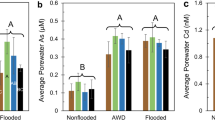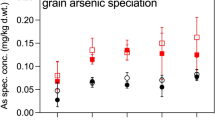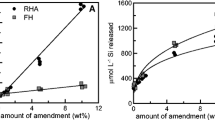Abstract
Rice is a global dietary staple and its traditional cultivation under flooded soil conditions leads to accumulation of arsenic (As) in rice grains. Alternate wetting and drying (AWD) is a widely advocated water management practice to achieve lower As concentrations in rice, water savings, and decreased methane emissions. It is not yet clear whether AWD leads to tradeoffs between concentrations of As and micronutrient elements (e.g., zinc, manganese, molybdenum) in rice grain. We analyzed pore water chemistry and rice grain composition data from a field experiment conducted in Arkansas, USA, in 2017 and 2018 to test the hypothesis that AWD will have diverging effects on oxyanion-forming (arsenic, molybdenum) vs. cationic (cadmium, zinc, manganese, copper) trace elements. This was hypothesized to occur via decreases in soil pH and/or precipitation of iron oxide minerals during oxidizing conditions under AWD. Solubility of all trace elements, except zinc, increased in more reducing conditions. Consistent with our hypothesis, AWD tended to increase grain concentrations of cationic elements while decreasing grain concentrations of oxyanionic elements. Decreases in total As in rice grains under AWD were mainly driven by changes in dimethylarsinic concentrations, with negligible changes in inorganic As. Linear mixed-effects modeling showed that effects of AWD on grain composition were more significant in 2017 compared to 2018. These differences may be related to the timing of dry-downs in the developmental stage of rice plants, with dry-downs during the heading stage of rice development leading to larger impacts on grain composition of certain elements. We also observed significant interannual variability in grain elemental composition from continuously-flooded fields and postulate the warmer temperatures in 2018 may have played a role in these differences.






Similar content being viewed by others
References
Abedin, M. J.; Cresser, M. S.; Meharg, A. A.; Feldmann, J.; Cotter-Howells, J., Arsenic accumulation and metabolism in rice (Oryza sativa L.). Environmental Science & Technology 2002, 36 (5), 962–968.
Arao, T., Kawasaki, A., Baba, K., Mori, S., & Matsumoto, S. (2009). Effects of water management on cadmium and arsenic accumulation and dimethylarsinic acid concentrations in Japanese rice. Environmental Science & Technology, 43(24), 9361–9367.
Bashir, K., Takahashi, R., Nakanishi, H., & Nishizawa, N. K. (2013). The road to micronutrient biofortification of rice: Progress and prospects. Frontiers in Plant Science, 4, 15.
Carrijo, D. R., Akbar, N., Reis, A. F., Li, C., Gaudin, A. C., Parikh, S. J., Green, P. G., & Linquist, B. A. (2018). Impacts of variable soil drying in alternate wetting and drying rice systems on yields, grain arsenic concentration and soil moisture dynamics. Field Crops Research, 222, 101–110.
Carrijo, D. R., Li, C., Parikh, S. J., & Linquist, B. A. (2019). Irrigation management for arsenic mitigation in rice grain: Timing and severity of a single soil drying. Science of the Total Environment, 649, 300–307.
Carrijo, D. R., LaHue, G. T., Parikh, S. J., Chaney, R. L., Linquist, B. A. (2022). Mitigating the accumulation of arsenic and cadmium in rice grain: A quantitative review of the role of water management. Science of The Total Environment, 2022, 156245.
Chi, Y., Li, F., Tam, N.F.-Y., Liu, C., Ouyang, Y., Qi, X., Li, W. C., & Ye, Z. (2018). Variations in grain cadmium and arsenic concentrations and screening for stable low-accumulating rice cultivars from multi-environment trials. Science of the Total Environment, 643, 1314–1324.
Dixit, S., & Hering, J. G. (2003). Comparison of arsenic (V) and arsenic (III) sorption onto iron oxide minerals: Implications for arsenic mobility. Environmental Science & Technology, 37(18), 4182–4189.
Farhat, Y. A., Kim, S.-H., Seyfferth, A. L., Zhang, L., & Neumann, R. B. (2021). Altered arsenic availability, uptake, and allocation in rice under elevated temperature. Science of the Total Environment, 763, 143049.
Fernández-Baca, C. P., McClung, A. M., Edwards, J. D., Codling, E. E., Reddy, V. R., & Barnaby, J. Y. (2021). Grain inorganic arsenic content in rice managed through targeted introgressions and irrigation management. Frontiers in Plant Science, 11, 612054.
Goldberg, S.; Su, C.; Forster, H. S., Sorption of Molybdenum on Oxides, Clay Minerals. Adsorption of metals by geomedia: Variables, mechanisms, and model applications 1998, 401.
Gustafsson, J. P. (2003). Modelling molybdate and tungstate adsorption to ferrihydrite. Chemical Geology, 200(1–2), 105–115.
Honma, T., Ohba, H., Kaneko-Kadokura, A., Makino, T., Nakamura, K., & Katou, H. (2016). Optimal soil Eh, pH, and water management for simultaneously minimizing arsenic and cadmium concentrations in rice grains. Environmental Science & Technology, 50(8), 4178–4185.
Hu, R.; Cooper, J. A.; Daroub, S. H.; Kerl, C. F.; Planer-Friedrich, B.; Seyfferth, A. L., Low levels of arsenic and cadmium in rice grown in southern Florida Histosols-Impacts of water management and soil thickness. Science of The Total Environment 2023, 161712.
Ishfaq, M., Farooq, M., Zulfiqar, U., Hussain, S., Akbar, N., Nawaz, A., & Anjum, S. A. (2020). Alternate wetting and drying: A water-saving and ecofriendly rice production system. Agricultural Water Management, 241, 106363.
Jia, Y., Huang, H., Zhong, M., Wang, F.-H., Zhang, L.-M., & Zhu, Y.-G. (2013). Microbial arsenic methylation in soil and rice rhizosphere. Environmental Science and Technology, 47(7), 3141–3148.
Kuo, S., & Baker, A. (1980). Sorption of copper, zinc, and cadmium by some acid soils. Soil Science Society of America Journal, 44(5), 969–974.
LaHue, G. T., Chaney, R. L., Adviento-Borbe, M. A., & Linquist, B. A. (2016). Alternate wetting and drying in high yielding direct-seeded rice systems accomplishes multiple environmental and agronomic objectives. Agriculture, Ecosystems & Environment, 229, 30–39.
Li, C., Carrijo, D. R., Nakayama, Y., Linquist, B. A., Green, P. G., & Parikh, S. J. (2019). Impact of alternate wetting and drying irrigation on arsenic uptake and speciation in flooded rice systems. Agriculture, Ecosystems & Environment, 272, 188–198.
Limmer, M. A., Wise, P., Dykes, G. E., & Seyfferth, A. L. (2018). Silicon decreases dimethylarsinic acid concentration in rice grain and mitigates straighthead disorder. Environmental Science & Technology, 52(8), 4809–4816.
Lindberg, R. D., & Runnells, D. D. (1984). Ground water redox reactions: An analysis of equilibrium state applied to Eh measurements and geochemical modeling. Science, 225(4665), 925–927.
Linquist, B. A., Anders, M. M., Adviento-Borbe, M. A. A., Chaney, R. L., Nalley, L. L., Da Rosa, E. F., & Van Kessel, C. (2015). Reducing greenhouse gas emissions, water use, and grain arsenic levels in rice systems. Global Change Biology, 21(1), 407–417.
Lowe, N. M. (2021). The global challenge of hidden hunger: Perspectives from the field. Proceedings of the Nutrition Society, 80(3), 283–289.
Maguffin, S. C., Abu-Ali, L., Tappero, R. V., Pena, J., Rohila, J. S., McClung, A. M., & Reid, M. C. (2020). Influence of manganese abundances on iron and arsenic solubility in rice paddy soils. Geochimica Et Cosmochimica Acta, 276, 50–69.
Martínez-Eixarch, M., Alcaraz, C., Guàrdia, M., Català-Forner, M., Bertomeu, A., Monaco, S., Cochrane, N., Oliver, V., Teh, Y. A., & Courtois, B. (2021). Multiple environmental benefits of alternate wetting and drying irrigation system with limited yield impact on European rice cultivation: The Ebre Delta case. Agricultural Water Management, 258, 107164.
Meharg, A. A., Williams, P. N., Adomako, E., Lawgali, Y. Y., Deacon, C., Villada, A., Cambell, R. C., Sun, G., Zhu, Y.-G., & Feldmann, J. (2009). Geographical variation in total and inorganic arsenic content of polished (white) rice. Environmental Science & Technology, 43(5), 1612–1617.
Monaco, S., Volante, A., Orasen, G., Cochrane, N., Oliver, V., Price, A. H., Teh, Y. A., Martínez-Eixarch, M., Thomas, C., & Courtois, B. (2021). Effects of the application of a moderate alternate wetting and drying technique on the performance of different European varieties in Northern Italy rice system. Field Crops Research, 270, 108220.
Muehe, E. M., Wang, T., Kerl, C. F., Planer-Friedrich, B., & Fendorf, S. (2019). Rice production threatened by coupled stresses of climate and soil arsenic. Nature Communications, 10(1), 4985.
Norton, G. J.; Douglas, A.; Lahner, B.; Yakubova, E.; Guerinot, M. L.; Pinson, S. R.; Tarpley, L.; Eizenga, G. C.; McGrath, S. P.; Zhao, F.-J., Genome wide association mapping of grain arsenic, copper, molybdenum and zinc in rice (Oryza sativa L.) grown at four international field sites. PloS one 2014, 9 (2), e89685.
Norton, G. J., Shafaei, M., Travis, A. J., Deacon, C. M., Danku, J., Pond, D., Cochrane, N., Lockhart, K., Salt, D., & Zhang, H. (2017a). Impact of alternate wetting and drying on rice physiology, grain production, and grain quality. Field Crops Research, 205, 1–13.
Norton, G. J., Travis, A. J., Danku, J. M., Salt, D. E., Hossain, M., Islam, M. R., & Price, A. H. (2017b). Biomass and elemental concentrations of 22 rice cultivars grown under alternate wetting and drying conditions at three field sites in Bangladesh. Food and Energy Security, 6(3), 98–112.
Potera, C., Food safety: US rice serves up arsenic. National Institute of Environmental Health Sciences: 2007.
Prom-U-Thai, C., Rashid, A., Ram, H., Zou, C., Guilherme, L. R. G., Corguinha, A. P. B., Guo, S., Kaur, C., Naeem, A., & Yamuangmorn, S. (2020). Simultaneous biofortification of rice with zinc, iodine, iron and selenium through foliar treatment of a micronutrient cocktail in five countries. Frontiers in Plant Science, 11, 589835.
R Core Team, R., R: A language and environment for statistical computing. 2013.
Rahman, M. A.; Hasegawa, H.; Rahman, M.; Miah, M.; Tasmin, A., Straighthead disease of rice (Oryza sativa L.) induced by arsenic toxicity. Environmental and Experimental Botany 2008, 62 (1), 54–59.
Reid, M. C., Asta, M. P., Falk, L., Maguffin, S. C., Pham, V. H. C., Le, H. A., Bernier-Latmani, R., & Le Vo, P. (2021). Associations between inorganic arsenic in rice and groundwater arsenic in the Mekong Delta. Chemosphere, 265, 129092.
Reid, M. C., Maillard, J., Bagnoud, A., Falquet, L., Le Vo, P., & Bernier-Latmani, R. (2017). Arsenic Methylation Dynamics in a Rice Paddy Soil Anaerobic Enrichment Culture. Environmental Science & Technology, 51(18), 10546–10554.
Runkle, B. R., Seyfferth, A. L., Reid, M. C., Limmer, M. A., Moreno-García, B., Reavis, C. W., Peña, J., Reba, M. L., Adviento-Borbe, M. A. A., & Pinson, S. R. (2021). Socio-technical changes for sustainable rice production: Rice husk amendment, conservation irrigation, and system changes. Frontiers in Agronomy, 3, 741557.
Runkle, B. R., Suvočarev, K., Reba, M. L., Reavis, C. W., Smith, S. F., Chiu, Y.-L., & Fong, B. (2018). Methane emission reductions from the alternate wetting and drying of rice fields detected using the eddy covariance method. Environmental Science & Technology, 53(2), 671–681.
Seyfferth, A. L., McCurdy, S., Schaefer, M. V., & Fendorf, S. (2014). Arsenic concentrations in paddy soil and rice and health implications for major rice-growing regions of Cambodia. Environmental Science & Technology, 48(9), 4699–4706.
Six, L., & Smolders, E. (2014). Future trends in soil cadmium concentration under current cadmium fluxes to European agricultural soils. Science of the Total Environment, 485, 319–328.
Somenahally, A. C., Hollister, E. B., Yan, W., Gentry, T. J., & Loeppert, R. H. (2011). Water management impacts on arsenic speciation and iron-reducing bacteria in contrasting rice-rhizosphere compartments. Environmental Science and Technology, 45(19), 8328–8335.
Sommella, A., Deacon, C., Norton, G., Pigna, M., Violante, A., & Meharg, A. (2013). Total arsenic, inorganic arsenic, and other elements concentrations in Italian rice grain varies with origin and type. Environmental Pollution, 181, 38–43.
Stahl, R. S., & James, B. R. (1991). Zinc sorption by iron-oxide-coated sand as a function of pH. Soil Science Society of America Journal, 55(5), 1287–1290.
Stone, R., Arsenic and paddy rice: a neglected cancer risk? American Association for the Advancement of Science: 2008.
Tang, Z., Wang, Y., Gao, A., Ji, Y., Yang, B., Wang, P., Tang, Z., & Zhao, F.-J. (2020). Dimethylarsinic acid is the causal agent inducing rice straighthead disease. Journal of Experimental Botany, 71(18), 5631–5644.
Williams, P. N., Islam, M., Adomako, E., Raab, A., Hossain, S., Zhu, Y., Feldmann, J., & Meharg, A. A. (2006). Increase in rice grain arsenic for regions of Bangladesh irrigating paddies with elevated arsenic in groundwaters. Environmental Science & Technology, 40(16), 4903–4908.
Williams, P. N., Villada, A., Deacon, C., Raab, A., Figuerola, J., Green, A. J., Feldmann, J., & Meharg, A. A. (2007). Greatly enhanced arsenic shoot assimilation in rice leads to elevated grain levels compared to wheat and barley. Environmental Science & Technology, 41(19), 6854–6859.
Zavala, Y. J., Duxbury, J. M. (2008). Arsenic in rice: I. Estimating normal levels of total arsenic in rice grain. Environmental Science & Technology, 42 (10), 3856–3860.
Zavala, Y. J., Gerads, R., Gürleyük, H., Duxbury, J. M. (2008) Arsenic in rice: II. Arsenic speciation in USA grain and implications for human health. Environmental Science & Technology, 42 (10), 3861–3866.
Zhang, X., & Reid, M. C. (2022). Inhibition of methanogenesis leads to accumulation of methylated arsenic species and enhances arsenic volatilization from rice paddy soil. Science of the Total Environment, 818, 151696.
Zhao, F.-J., & Wang, P. (2020). Arsenic and cadmium accumulation in rice and mitigation strategies. Plant and Soil, 446, 1–21.
Zhao, F.-J., Zhu, Y.-G., & Meharg, A. A. (2013). Methylated arsenic species in rice: Geographical variation, origin, and uptake mechanisms. Environmental Science and Technology, 47(9), 3957–3966.
Zheng, M. Z., Cai, C., Hu, Y., Sun, G. X., Williams, P. N., Cui, H. J., Li, G., Zhao, F. J., & Zhu, Y. G. (2011). Spatial distribution of arsenic and temporal variation of its concentration in rice. New Phytologist, 189(1), 200–209.
Acknowledgements
This research was funded by the grant USDA-NIFA-2018-67019-27796 and an NSF Earth Science Postdoctoral Fellowship awarded to S. Maguffin (award number 1625317). The authors thank T. Sookaserm and L. Sells (DBNRRC, USDA-ARS) for field assistance and M. Thomas from the Cornell Statistical Consulting Unit for assistance with linear mixed effects modeling. Pore water samples were analyzed at the Dartmouth Trace Element Core Facility, which was established by grants from the National Institute of Health (NIH) and National Institute of Environmental Health Sciences (NIEHS) Superfund Research Program (P42ES007373) and the Norris Cotton Cancer Center at Dartmouth Hitchcock Medical Center.
Funding
National Institute of Food and Agriculture,2018-67019-27796,2018-67019-27796.
Author information
Authors and Affiliations
Contributions
L.A-A and SCM performed research under supervision of MCR, AM, and JR, LA-A and MCR wrote the first draft of the manuscript text and AM and JR contributed to the final draft of the manuscript text. SCM and MCR acquired research funding and designed research with AM and JR.
Corresponding author
Ethics declarations
Conflict of interest
The authors declare no competing interests.
Additional information
Publisher's Note
Springer Nature remains neutral with regard to jurisdictional claims in published maps and institutional affiliations.
Supplementary Information
Below is the link to the electronic supplementary material.
Rights and permissions
Springer Nature or its licensor (e.g. a society or other partner) holds exclusive rights to this article under a publishing agreement with the author(s) or other rightsholder(s); author self-archiving of the accepted manuscript version of this article is solely governed by the terms of such publishing agreement and applicable law.
About this article
Cite this article
Abu-Ali, L., Maguffin, S.C., Rohila, J.S. et al. Effects of alternate wetting and drying on oxyanion-forming and cationic trace elements in rice paddy soils: impacts on arsenic, cadmium, and micronutrients in rice. Environ Geochem Health 45, 8135–8151 (2023). https://doi.org/10.1007/s10653-023-01702-9
Received:
Accepted:
Published:
Issue Date:
DOI: https://doi.org/10.1007/s10653-023-01702-9




